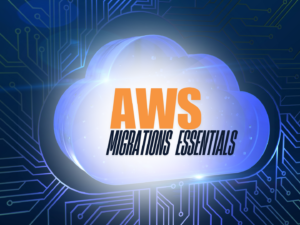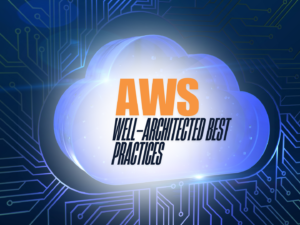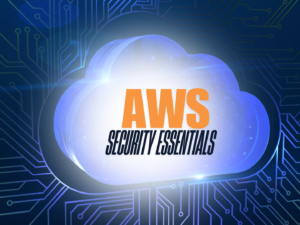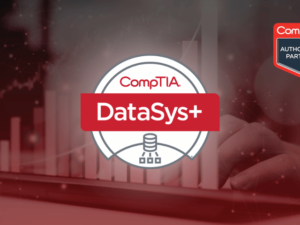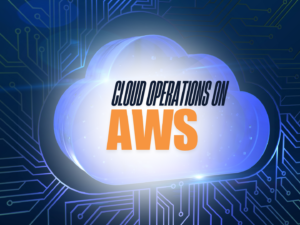MIGRATING TO AWS
- Description
- Reviews

Course Overview
Introduction
This course provides IT professionals with the essential knowledge and hands-on experience needed to successfully migrate workloads to Amazon Web Services (AWS). Learn best practices, strategies, and tools to ensure a smooth and secure transition to the cloud.
Business Relevance
Migrating to AWS enhances business operations by reducing infrastructure costs, improving scalability, and strengthening IT security. This training helps organizations streamline cloud adoption while ensuring compliance and operational efficiency.
Target Area
Cloud management, IT infrastructure modernization, cybersecurity, and IT governance.
What You’ll Learn & Who Should Enroll
Key Topics Covered:
- AWS Migration Strategies: Understand the “6 Rs” of cloud migration and determine the best approach for your business needs.
- AWS Migration Tools & Services: Explore AWS services like AWS Migration Hub, Server Migration Service (SMS), and Database Migration Service (DMS).
- Security & Compliance in AWS Migration: Learn how to implement security best practices, data protection, and regulatory compliance during migration.
- Cost Optimization & Performance Management: Discover techniques to optimize cloud resources for cost efficiency and operational performance.
- Hands-On Migration Experience: Gain practical experience with real-world migration scenarios and AWS best practices.
Ideal Participants:
This course is designed for:
- IT Leaders & Managers: Improve decision-making for cloud migration and IT modernization strategies.
- Enterprise IT Teams: Execute cloud migration projects efficiently and ensure regulatory compliance.
- Security & Compliance Officers: Strengthen risk management, data security, and regulatory adherence during cloud adoption.
- Cloud & Infrastructure Engineers: Enhance expertise in AWS migration tools and methodologies.
Business Applications & Next Steps
Key Business Impact:
- Enhanced Security & Compliance: Implement robust security frameworks and ensure regulatory compliance.
- Improved IT Governance: Establish standardized cloud management practices and risk mitigation strategies.
- Operational Efficiency: Optimize IT infrastructure, reduce costs, and enhance scalability with AWS cloud solutions.
Next-Level Training:
To further build expertise, consider:
- Deep Learning on AWS: Explore AI and machine learning capabilities on AWS for advanced cloud solutions.
- AWS Certified Solutions Architect – Associate: Strengthen architectural best practices for AWS cloud infrastructure.
- AWS Certified Advanced Networking – Specialty: Gain expertise in designing and implementing AWS networking solutions for complex cloud environments.
Why Choose Acumen IT Training?
- Enterprise-Focused Curriculum: Designed specifically for corporate IT teams facing cloud migration challenges.
- Expert-Led Training: Learn from experienced AWS professionals with real-world expertise.
- Business-Driven Learning: Gain practical skills that directly impact your organization’s IT transformation.
- Flexible Training Options: Choose from Online, Hybrid, Instructor-Led On-Site (at your location or ours), and Corporate Group Sessions.
For the full course outline, schedules, and private corporate training inquiries, contact us at Acumen IT Training.
Course Outline
COURSE OBJECTIVES
- Recognize the common business and technical drivers for migrating to the cloud
- Summarize the three phases of a migration and associated objectives, tasks, and stakeholders for each
- Describe AWS architecture, tools, and migration best practices
- Distinguish between the various cloud migration strategies and when each is most appropriate
- Determine an organization’s application migration readiness
- Discover a portfolio and gather data necessary for migration
- Plan and design an application migration strategy
- Perform and validate application migration to the cloud
- Optimize applications and operations after migrating to the cloud
TRAINING INCLUSIONS
- Comprehensive training materials and migration strategy guides
- Hands-on labs with real-world cloud migration scenarios
- Migrating to AWS Certificate of Training Completion
- Access to AWS migration tools, including AWS Migration Hub, AWS DMS, and AWS Server Migration Service
- 30 Days Post-Training Support
COURSE OUTLINE
Module 1: What Is a Cloud Migration?
Module 2: Assessing Migration Readiness
Module 3: Preparing for a Migration and Understanding Related Workstreams
Module 4: Discovering Landing Zones and Their Benefits
Module 5: Building a Landing Zone
Module 6: Discovering the Portfolio and Understanding Migration Strategies
Module 7: Understanding and Choosing Portfolio Discovery Tools
Module 8: Planning and Designing a Migration
Module 9: Performing the Migration to AWS
Module 10: Understanding Database and Data Migration Services
Module 11: Understanding Additional Migration Support Options
Module 12: Integrating, Validating, and Cutting Over Applications
Module 13: Modernizing and Optimizing Applications
Module 14: Understanding Operations Tools, Integration Testing, and Automation
Module 15: Migration Best Practices
For FULL COURSE OUTLINE, please contact us.
Inquire now for schedules and private class bookings
FAQs
- What is Migrating to AWS training?
This course provides an in-depth understanding of AWS migration strategies, tools, and best practices for moving on-premises workloads to AWS cloud infrastructure. - Who is this training for?
It is designed for IT professionals, system administrators, cloud engineers, and business leaders involved in cloud migration projects. - Do I need prior AWS experience to take this course?
Basic knowledge of cloud computing and IT infrastructure is recommended but not required. - What skills will I learn in this training?
You will learn how to plan, execute, and optimize cloud migrations using AWS services such as AWS Migration Hub, AWS DMS, and AWS Application Discovery Service. - How long is the training program?
The training spans five days, covering both theoretical concepts and hands-on exercises. - What is the format of the certification exam?
The exam consists of multiple-choice and scenario-based questions evaluating AWS migration strategies and best practices. - Is this training available online?
Yes, we offer both online and in-person training options. - How will Migrating to AWS training benefit my career?
This training enhances your expertise in cloud migration, making you a strong candidate for roles in cloud architecture, IT operations, and digital transformation projects. - How long is the certification valid?
The certification is valid for three years and can be renewed through AWS continuous learning programs. - What career opportunities are available after completing this training?
You can pursue roles such as cloud migration specialist, cloud solutions architect, and IT infrastructure consultant.
Real-World Applications of Migrating to AWS
Case Study 1: E-Commerce Platform Migration
Challenge: A retail company experienced frequent website crashes and slow performance during peak sales seasons.
Solution: The company migrated its e-commerce platform to AWS, leveraging auto-scaling and managed database services.
Result:
✅ Improved uptime from 95% to 99.5%, minimizing disruptions during peak traffic
✅ Website load times reduced by 40%, enhancing customer experience
✅ 30% cost savings by eliminating expensive on-premises server maintenance
Case Study 2: Enterprise Data Center Migration
Challenge: A multinational corporation faced high costs and security risks due to aging on-premises data centers.
Solution: The company transitioned to AWS using a hybrid cloud approach, leveraging AWS Direct Connect and Amazon S3 for data storage.
Result:
✅ Reduced infrastructure costs by 35%, lowering capital expenses
✅ Enhanced security compliance, with AWS’s built-in security and monitoring tools
✅ Faster data processing speeds, improving operational efficiency by 50%
Use Case 1: Disaster Recovery Optimization
A financial services company set up AWS-based disaster recovery, ensuring business continuity in case of system failures.
✅ Recovery time reduced from hours to minutes
✅ Data replication ensures no data loss during failures
Use Case 2: Legacy System Modernization
A healthcare provider migrated legacy applications to AWS, improving system reliability and reducing maintenance costs.
✅ Improved system performance by 60%
✅ Eliminated hardware upgrade costs
Why These Case Studies Matter for You
Migrating to AWS isn’t just about moving data—it’s about enhancing efficiency, cutting costs, and improving business resilience. These case studies show how real organizations have successfully tackled migration challenges, making their systems more scalable, secure, and cost-effective. By mastering AWS migration, you can help businesses transition smoothly to the cloud while maximizing their ROI.
🔗Enroll today and take the next step in your cloud journey with AWS migration expertise!
Testimonials: What Professionals Say About Our Migrating to AWS Training
⭐ ⭐ ⭐ ⭐ ⭐ “Transformed Our IT Infrastructure!”
“This training gave me the confidence to lead our company’s migration project. AWS tools make the transition seamless!”
— Henry R., cloud migration specialist, retail industry
⭐ ⭐ ⭐ ⭐ ⭐ “A Must-Have for IT Professionals!”
“AWS migration training helped us modernize our legacy systems efficiently. The hands-on labs were extremely useful.”
— Josephine C., IT manager, finance sector
⭐ ⭐ ⭐ ⭐ ⭐ “Practical and Insightful!”
“This course covered everything from planning to execution. I was able to apply my knowledge immediately at work.”
— Carlos M., systems engineer, telecommunications
Request a Quote
Popular Courses
Archive
Working hours
| Monday | 9:00 am - 6.00 pm |
| Tuesday | 9:00 am - 6.00 pm |
| Wednesday | 9:00 am - 6.00 pm |
| Thursday | 9:00 am - 6.00 pm |
| Friday | 9:00 am - 6.00 pm |
| Saturday | Closed |
| Sunday | Closed |

